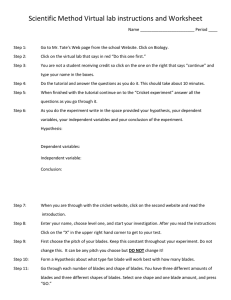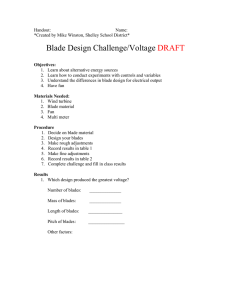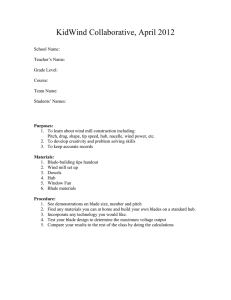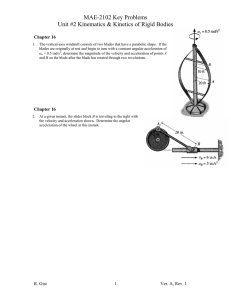Document 12142171
advertisement
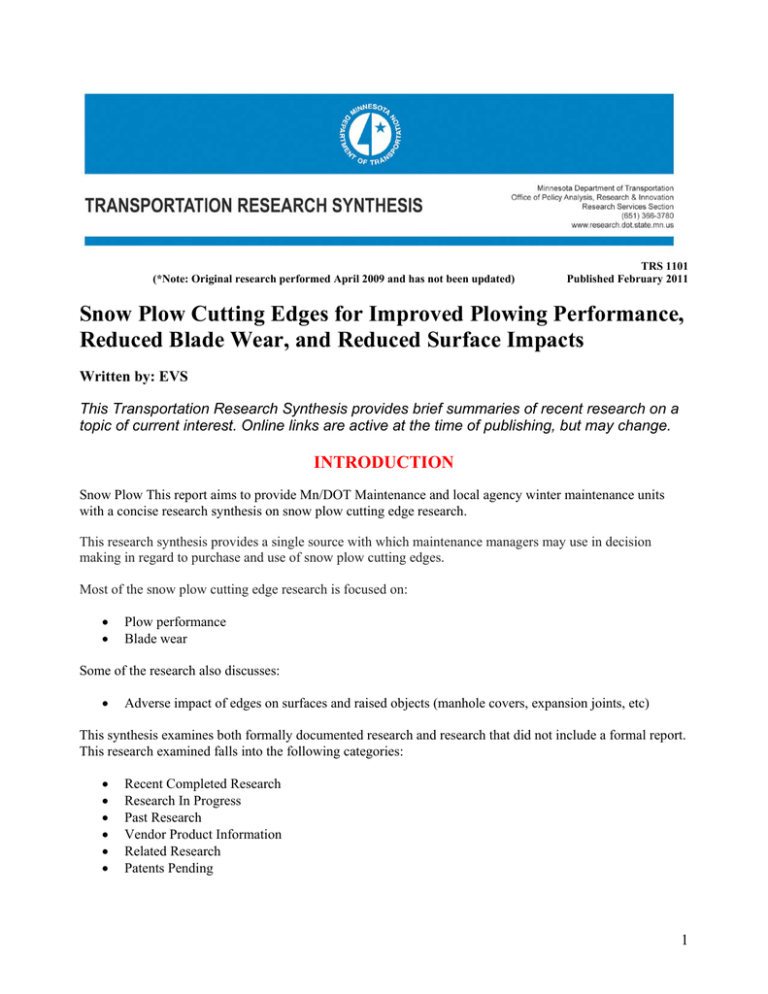
(*Note: Original research performed April 2009 and has not been updated) TRS 1101 Published February 2011 Snow Plow Cutting Edges for Improved Plowing Performance, Reduced Blade Wear, and Reduced Surface Impacts Written by: EVS This Transportation Research Synthesis provides brief summaries of recent research on a topic of current interest. Online links are active at the time of publishing, but may change. INTRODUCTION Snow Plow This report aims to provide Mn/DOT Maintenance and local agency winter maintenance units with a concise research synthesis on snow plow cutting edge research. This research synthesis provides a single source with which maintenance managers may use in decision making in regard to purchase and use of snow plow cutting edges. Most of the snow plow cutting edge research is focused on: • • Plow performance Blade wear Some of the research also discusses: • Adverse impact of edges on surfaces and raised objects (manhole covers, expansion joints, etc) This synthesis examines both formally documented research and research that did not include a formal report. This research examined falls into the following categories: • • • • • • Recent Completed Research Research In Progress Past Research Vendor Product Information Related Research Patents Pending 1 KEY STUDIES AT A GLANCE The following table summarizes key research. Following the table are research summaries of these studies and other studies, a list of key experts and subject champions, and report conclusions. Summary of Key Research Improved Blade Wear Reduction of Impact to Surface, Pavement Markings, etc Overall Improvement Subject Research Year Improved Plow Performance Rubber-Encased Steel Blades WisDOT Evaluation 2001 Yes Yes Yes Yes Rubber-Encased Steel Blades Ohio DOT Evaluation 2008 Yes Yes Yes Yes Rubber-Encased Steel Blades Clear Roads Product Experience Feedback (OH, MO, MN) 2008 Yes Yes Yes Yes 2006 Yes Yes (Bituminous) - Yes (Bituminous) Rubber-Encased Steel Blades Mn/DOT Maintenance Research Rubber-Encased Steel Blades Iowa DOT Evaluation 2001 Yes Yes Yes Yes Alternative Carbide Edge Snow Blades Maine DOT Evaluation 2004 No No - No Solid Rubber Blades Mn/DOT Evaluation 2008 No No - No Adjustable Blade System Iowa DOT Tests 20082009 2 Iowa DOT has research in progress testing blades such as custom-made adjustable systems RESEARCH SUMARIES The following is a list of research summaries listed by category. Each research summary starts with an “#Id” field which is just a unique identifier unique to this report for reference purposes. This is followed by a title describing the research, a source/publisher, a date if available, and finally a summary of the research. Recently Completed Research #1029 Ohio DOT Evaluation of JOMA rubber-encased steel plow blades Ohio DOT - Diana Clonch / George W. Fowler / David Paponetti 2008 A pilot study was conducted using JOMA rubber-encased steel plow blades by the Ohio Department of Transportation. The results showed that snowplow drivers preferred the new blades and the new blades were preferred by snow plow drivers, and the new blades had less adverse impact on surfaces. Other advantages including longer blade life, less maintenance (reduced welding), much lighter for installation and maintenance, less road surface impact, less driver fatigue. #1030 Iowa DOT Evaluation of JOMA Blades Iowa DOT - Dennis Burkheimer 2001 http://www.iowadot.gov/maintenance/internetpages/equipment/jomablades.htm Eleven maintenance shops tested JOMA 6000 rubber-encased steel blades through the winter seasons of 1999-2001. The study results were favorable in terms of the new blades. The study stated "All agreed that they would be a benefit to the fleet to have these available on plows because they performed well and had the additional bonus that they made the ride smoother and quieter as well as making installation and removal safer for operators. The evaluation group concluded: "The group very strongly agreed with all the manufacturers claims of benefits with the use of this blade and felt the benefits override the costs. Benefits such as less vibration and stress on the equipment, reduced noise and jarring in the cab and reduced risk for employee safety are difficult benefits to measure. Quicker and easier installation, reduced material use and fewer plow passes are quantifiable but were not measured for this operational test." (from "Black Cat Blade (JOMA 6000) Test and Evaluation" report). #1037 WisDOT Evaluation of Black Cat JOMA 6000 Snow Plow Blade WisDOT August 2001 The Black Cat JOMA 6000 rubber-encased steel blade snow plow blade was used and evaluated by 22 Wisconsin County Highway Departments during the 1999-2000 and 2000-2001 winter seasons. Evaluations were then completed by each department. The evaluation reported advantages of the JOMA blades for the following reasons: easier to install, longer blade life, quieter, cleaner roads, better action over ie raised pavement markers. The evaluation reported disadvantages of the JOMA blades were higher cost and possible increased wear on the JOMA blades when plowing shoulders and when plowing roadways only partially covered with snow. 3 #1031 Clear Roads JOMA Blades Product Experience Feedback Responses for 2007 - 2008 Winter Clear Roads 2008 http://www.clearroads.org/2007-08_ProductExperienceFeedback.pdf A Clear Roads evaluation of the JOMA rubber-encased steel blade was conducted for the winter of 2007-2008 in Ohio, Missouri, and Minnesota. Results of the evaluations were favorable towards the JOMA blades. The advantages reported included longer blade life, reduction of noise and vibration thus reducing operator and equipment fatigue, better plow conformance/performance on the pavement surface, and reduction in de-icing materials needed. #1027 Maine DOT Evaluation of Alternative Carbide Edge Snow Blades Maine Department of Transportation March 2004 http://www.maine.gov/mdot/transportation-research/pdf/Report0311t.pdf Maine spends approximately $150,000 each winter season (2004) on carbide snowplow cutting edge expenditures. The study looked at an alternative carbide edge snow plow blade versus conventional carbide blades. "Preliminary results seem to indicate that the new blades do not last as long as regular stock blades." The conventional blade is carbide inserted into a grove cut into the underside of a steel plow blade. The new blades were isolated carbide tipped blades (ie small round plugs of carbide that are inserted into round holes drilled into the steel blade). #1038 Evaluation of 1.5 inch Solid Rubber Blades (2008) Mn/DOT - Ryan Otte / John Giguere / Cliff Gergen Oct 9 2008 Mn/DOT conducted evaluation of 1.5 inch solid rubber blades (report date October 9, 2008). The study reported that the blades did not work well. Relative to conventional steel blades, they were more difficult to install, wore out quicker, and did not perform as well (did not clean snow as well). The results were inconclusive relative to determining if the rubber blades would have less adverse impact on pavement markings. The study listed possible modifications of the blade that might improve it. These included using the blade as a "slush blade" about a foot behind the main blade, and also providing a "cover plate" over parts of the rubber blade to decrease blade wear and damage by bolts. #1006 Winter Highway Operations - A Synthesis of Highway Practice TRB 2005 http://onlinepubs.trb.org/Onlinepubs/nchrp/nchrp_syn_344.pdf Alberta, Missouri, and Saskatchewan noted using advancements made in their plow designs. Maryland uses rubber blades on some plows, as does Oregon. Oregon also uses ultra-high molecular weight polymer moldboard plows. One improvement based on research is the flush-mounted, carbide insert at the front edge of the blade and a non-zero clearance angle (Nixon 1993). #1024 Pavement Distress (Raveling) Due to Snow Plow Blades HAPI Asphalt Pavement Guide 2003 http://www.hawaiiasphalt.com/HAPI/modules/03_general_guidance/03_pavement_distress.htm 4 Pavement raveling is "Mechanical dislodging by certain types of traffic (studded tires, snowplow blades or tracked vehicles)." #1039 Joma 6000Blade System (rubber cutting edges) Mn/DOT Maintenance Research 4/27/06 District 3/B / Elk River Sub Area / Milaca Truck Station Project Contacts: Terry Newgard, Ryan Otte This study compared the Joma 6000 blades versus conventional blades. The Joma 6000 blades were preferred because of less vibration and noise (less driver fatigue), reduced plow wear (durability), and the blade conformed better with the road (better plowing performance). In terms of cost, on bituminous roads the Joma 6000 blade was less expensive than conventional when blade life is considered. On concrete roads, the Joma blade is more expensive. The report recommends using the Joma 6000 on bituminous snowplow routes. Research In Progress #1036 Iowa Dot Is Testing A Home-Made Adjustable Blade System Iowa DOT - Dennis Burkheimer 2008-9 A Clear Roads project is the multiple edge plow project where they have paid four manufacturers to build prototype plows for five states to test this winter. The St. Cloud, MN garage has one of the prototypes built by Henderson, Mfg. Iowa, Indiana, Ohio and Wisconsin are the other testing locations testing plows by Flink, Henderson, Henke and Monroe. All of the plows are using some combination of a carbide, scarifying and squeegee blade. The idea is to develop a “Swiss army knife” or universal cutting edge system for snow removal to clear in one-pass. More information on the Clear Roads web site in late 2009. #1032 Retesting of JOMA 6000 Blades Iowa DOT - Dennis Burkheimer 2009 The Iowa DOT is retesting the JOMA 6000 blades at several garages in Northern Iowa. This is a retest related to the 2001 project "Iowa DOT Evaluation of JOMA Blades". Increases in the cost of carbide blades in the last few years is the reason for the study. The 2001 project was very favorable in regard to the JOMA blades, but a 4:1 cost ratio made it hard to justify them. #1035 Iowa Dot Is Testing A Home-Made Adjustable Blade System Iowa DOT - Dennis Burkheimer 2008-9 IOWA DOT is testing a home-made adjustable blade system that is divided into one-foot sections and secured to the moldboard by two bolts. The bolts are surrounded by a rubber grommet in a slightly oversized hole. The idea is to provide some range in motion for the one-foot sections to adjust to the contour of the roadway. 5 #1034 IOWA DOT is Testing an Active Adaptor Blade Iowa DOT - Dennis Burkheimer 2008-9 IOWA DOT is testing an Active Adaptor blade. "While it is not an actual blade it's an adaptor that is attached to the plow and blade that allows the blade to adjust to the contours of the roadway." #1033 IOWA Dot Testing of a Ceramic Blade Offered By Kennametal Iowa DOT - Dennis Burkheimer 2009 The IOWA DOT is testing a ceramic blade offered by Kennametal in Northern Iowa. The ceramic is encased in rubber to help provide some adjustment to the contours of the road. #1026 Standardization of Blade Wear Testing Clear Roads 07-01/WisDOT 0092-08-31 Due July 2009 http://www.clearroads.org/07-01carbideinsert.html Standardization of Blade Wear Testing. Past Research Snow Plow Optimization - St Louis County TRB 2007-2010 "St Louis County will be contracting with the U of M and we will send the LRRB funding to them via state aid master agreement, in the amount of $45,000.00 to see if there is benefits for all cities/counties from the study." (TRB) #1019 Improved Snow blade being developed by the University of Wyoming under project H-206 Michigan Technological University 1993 http://onlinepubs.trb.org/Onlinepubs/shrp/SHRP-H-644.pdf Further investigation of preventing pavement damage is necessary. ...... to the snow plow blade being developed by the University of Wyoming under project H ... #1003 Rubber Snowplow Blades And Lightweight Snowplows Used For The Protection Of Raised Lane Markers Highway Research Board 1971 http://pubsindex.trb.org/document/view/default.asp?lbid=111036 Results are presented of a 2-year study to expand the experience gained by earlier experiments with the rubber snow plow blade. #1017 Blade Design For Reduced Road Damage Strategic Highway Research Program 1994 http://onlinepubs.trb.org/Onlinepubs/shrp/SHRP-H-673.pdf "Better blade/mechanism design* In regard to ie gouging the road, tripping blades present many of the 6 same problems as full tripping moldboards; however, in some cases the magnitude of the problem is reduced (design shown). Based on the discussion above a tripping blade design is recommended rather than tripping moldboard." #1018 Road Damage Related to Blade Angle Iowa Institute of Hydraulic Research 1993 http://onlinepubs.trb.org/Onlinepubs/shrp/SHRP-H-346.pdf "Improved Cutting Edges for Ice Removal It should be noted that it would be impractical to use a blade with an angle equal to 10°, the mean value used in Huang's tests. Such a blade would easily break and might also damage the road surface by digging into it. Ice is more effectively cut when this angle is between 45 ° and 90 °." #1005 Field Testing Of New Cutting Edges For Ice Removal From Pavements Nixon W A 1993 http://pubsindex.trb.org/document/view/default.asp?lbid=379642 One of the more severe winter hazards is ice or compacted snow on roadways. Three methods are typically used to combat ice--salting, sanding and scraping--but relatively little effort has been applied to improve methods of scraping ice from roads. A new test facility is described, including a truck with an underbody blade that has been instrumented such that the forces to scrape ice from a pavement can be measured. #1001 Plowing Efficiency Strategic Highway Research Program (SHRP) 1991 http://onlinepubs.trb.org/Onlinepubs/shrp/SHRP-H-319.pdf References other documents. "Strategic Highway Research Program (SHRP) is developing an advanced snow plow blade, cutting edge, and snowscoop attachment. The goal is a 20 percent increase in plowing efficiency." #1040 Motor Grader and Snowplow Cutting Edge Durability Study LRRB 1993 "This report presents an evaluation of the wear characteristics of five types (carbon, flame-hardened, thru-hardened, carbide insert, and a new treatment, austempered) of cutting edges used in the maintenance of gravel roads." (LRRB) Patent Pending #1025 Patent for Fracture resistant carbide snowplow and grader blades freepatentsonline 2005 http://www.freepatentsonline.com/6854527.html 7 Patent for snowplow blade that is durable and fracture resistant Study Failed #1002 Snow Plow Cutting Edge Test And Evaluation, Iowa Institute Of Hydraulic Research February 1999 http://www.iihr.uiowa.edu/products/cold_regions/publications/ld277.pdf Study failed to accomplish goals. Study failed to analytically compare cutting edges. Also named "H206 Project". Related Research #1004 Design of Modular Bridge Joint Systems (MBJS) to avoid snowplow damage Transportation Research Board 2002 MBJS should be placed slightly lower than deck surface to avoid snow plow edges. Some MBJS designs call for a MBJS skew angle of 20 degrees so that it is smaller than the assumed 30 degree snow plow blade angle. If the angles coincide the probability of severe damage to the seal, etc increases. #1023 Development of Recessed Pavement Markings that Incorporate Rumble Strips TRB 2008 http://pubsindex.trb.org/document/view/default.asp?lbid=848032 Development of Recessed Pavement Markings that Incorporate Rumble Strips Vendor Product Information #1022 Enhanced JOMA blade system Winter Equipment 2008 http://www.winterequipment.com/SnowplowBlades/Joma6000.htm Enhanced JOMA blade system #1020 A new snowplow blade aimed at improving highway snow removal operations and reduce damage to road The Bridge October/December 2000 http://www.michiganltap.org/pubs/bridge/pdf/2000/brdg15_1.pdf JOMA 6000 is an blade design that attempts to improve highway snow removal operations and reduce damage to road. The Iowa Department of Transportation tested sets of blades during the winter of 19992000 with generally favorable results. Benefits included less passes (thus less material use and wear) less vibration (less noise and jarring in cab) and good snow removal in wheelpaths. 8 #1028 Active Blade Adapter System (ABAS) Clear Roads Program April 2006 http://www.ctre.iastate.edu/research/conceptv/phase5/Clear%20Roads%20White%20Paper.pdf "The Active Blade Adapter System was invented in Finland and is used extensively throughout both Finland and Sweden. The basic concept of the system is that it converts your present rigid plowing system into a free floating system." The system aims to yield advantages which include extending blade life by absorbing shock, reducing wear and tear on equipment, no damage to raised pavement markers (RPM's), more effectiveness especially in high-speed plowing. #1021 Improved Gravel Road Snow Removal Blade The Bridge October/December 2000 http://www.michiganltap.org/pubs/bridge/pdf/2000/brdg15_1.pdf "It is self-sharpening, featuring an innovative design of successive rows of holes and new cutting edges continuously emerge as the blade is worn down." The street superintendent for Isanti Township in Minnesota gave the blade high marks for snow plowing efficiency, and also performs better along the edge of the road (if sod is encountered by the blade). #1010 Polyurethane Snowplow Blades Product Info Rubber-Cal http://rubbercal.com/snowplow.html Rubber or polyurethane snow plow blades are designed to fit all types of equipment that use steel blades. Flexible blades conform to road surfaces, minimizing surface damage, protecting airport runway lights, and highway lane markers. #1016 Urethane Snow Plow Blades (Book Reference) http://capemay.njstatelib.org/ipac20/ipac.jsp?session=1231O968249I0.80204&profile=njl-1&uri=link=3100009~!627899~!3100001~!3100002&aspect=subtab24&menu=search&ri=1&source=~ !horizon&term=Snow+plows+--+Materials+--+Evaluation.&index=PSUBJ#focus *book reference* Evaluation of urethane snow plow blades as an alternative to rubber blades / D.S. Roosevelt. by Roosevelt, Daniel S. Charlottesville : Virginia Transportation Research Council; [Springfield, VA. : Available through the National Technical Information Service, 1995] #1013 Urethane Blades Discussion http://www.plowsite.com/archive/index.php/t-37686.html group discussion about urethane blades on the highway plow #1012 Improving Snow Plow Design http://74.125.95.132/search?q=cache:LfhfQpCYGOEJ:www.ctre.iastate.edu/research/conceptv/phase5/ Clear%2520Roads%2520White%2520Paper.pdf+steel+blade+snow+plow+damage+road+surface&hl=e n&ct=clnk&cd=13&gl=us Improving Snow Plow Design: Highway Maintenance Concept Vehicle Phase V Prepared for the Clear Roads Program Field Testing of Alternative Carbide Edge Snow Plow Blades 9 #1014 Urethane Snow Plow Blades Vs. Rubber Blades http://vtrc.virginiadot.org/PubDetails.aspx?PubNo=96-R2 Evaluation of urethane snow plow blades as an alternative to rubber blades #1015 Reduction In Pavement Damage: Polyurethane Plow Blade http://www.pleiger.com/snow.html Plei-Tech® 22 polyurethane plow blade edges are specifically manufactured to your snow removal specifications Advantages: Less damage to plowed surfaces, less plow chatter, longer snow plow service life. Principal Clients: Airports, state highway departments, and OEM?s. Contact Pleiger Plastics today for a quote on your snow removal application. #1009 Rubber Snow Plow Blades Product Info Longwood Industries http://www.longwoodindustries.com/products/detail.php?s=T-SNOW-R Rubber Snow Plow Blades #1007 Polyurethane parts push snow, spread salt Advanced Materials & Processes / Entrepreneur Jan 2001 https://www.entrepreneur.com/tradejournals/article/69675444.html MT&S Artic-Groomer blade edge : "When you push a steel blade down the road in direct contact with the road surface and it hits something that doesn't want to move... something has to give," says Hill. "You can damage the roadway and the plowing equipment or possibly injure the driver -- an experience known among plow drivers as 'eating the wheel."' However, when an MT&S Artic-Groomer blade edge contacts an obstacle, it "bends or compresses, then snaps back into shape since it's elastomeric," explains Hill. "Users of our blade edges are experiencing less equipment damage, fewer operator injuries, and reduced damage to road surfaces, curbs, and manholes." #1008 ArticGroomer snowplow blade edges Product Design & Development http://www.pddnet.com/Scripts/ShowPR~PUBCODE~045~ACCT~0014237~ISSUE~0101~RELTYPE ~PR~PRODCODE~56550~PRODLETT~A.asp ArticGroomer snowplow blade edges, manufactured by Material Technologies & Sciences Inc. (MT&S) with polyurethane elastomer raw materials from Bayer Corp., are designed to reduce damage to roads and equipment, help operators avoid injuries, and offer improved removal of snow and slush Also see http://findarticles.com/p/articles/mi_hb6619/is_/ai_n28808051 #1011 Improved Blade Design: Tungsten Carbide Inserted Segments Vulcanized In Rubber Better Roads http://obr.gcnpublishing.com/articles/prod101.htm After some minor design changes, very promising results have been obtained from initial evaluations of the newly introduced JOMA 6000 high-speed snow plow blade. About 350 sets of these blades were 10 installed across North America in a wide variety of applications to evaluate effectiveness. "All of the company's claims about the JOMA blade are true according to the five test locations that used the blades this past winter," says Dennis Burkheimer, Iowa Department of Transportation. The cutting edge consists of independent tungsten carbide inserted segments vulcanized in rubber. This is the first major innovation in highway snow plowing blades since the advent of carbide inserted steel blades in the 1970s. The problem with a steel inserted blade is that vibration, chatter, and bouncing of the plow impact the tungsten carbide insert, fracturing the surface, resulting in chipping rather than wear. The first major benefit of the new blade is the shock absorption characteristics of the rubber mounting that result in a dramatic improvement in wear. The tungsten carbide insert is allowed to run smoothly on the road surface and wear out rather than chip away. KEY EXPERTS AND SUBJECT CHAMPIONS Name Key Experts And Subject Champions Organization Ryan Otte, Research Project Manager Mn/DOT Cliff Gergen Mn/DOT Jack Herndon Ben Worel Roger Olson Bernard Izevbekhai Mn/DOT Mn/DOT Mn/DOT Mn/DOT Michael Sproul WisDOT Paul Pisano Wilfrid Nixon Winter Maintenance Scan Team Members dot.gov University of Iowa Jan Olander Jon Dahlen Sue Miller Paul Kauppi Dennis Burkheimer George W. Fowler, Management Analyst Supervisor David Paponetti, Transportation Administrator Diana Clonch, Assistant Administrator, Office of Maintenance Winter Maintenance Expert, Sweden Winter Maintenance Expert, Norway Freeborn County, MN City of Woodbury, MN Iowa DOT Contact Information Ryan.Otte@state.mn.us Clifford.Gergen @state.mn.us 651/297-2996 651/366-5522 651/366-5517 651/366-5454 michael.sproul @dot.wi.gov paul.pisano@dot.gov wilfrid-nixon@uiowa.edu jan.olander@vv.se jon.dahlen@vegvesen.no sue.miller @co.freeborn.mn.us pkauppi@ci.woodbury.mn.us Dennis.Burkheimer @dot.iowa.gov ODOT District 12 gfowler@dot.state.oh.us Lake County, ODOT david.paponetti @dot.state.oh.us ODOT Diana.clonch @dot.state.oh.us 11 CONCLUSIONS / RECOMMENDATIONS Rubber-Encased Steel Blades have been tested and evaluated in several states with favorable results. These blades have traditionally been more expensive than conventional steel blades and in some cases this has been cost prohibitive. Winter maintenance organizations may wish to consider doing a cost analysis evaluation for using these blades. Some of the benefits are measurable, while others such as operator safety and reduction in operator fatigue may be intangible and difficult to measure. Much of the past and current research has been focused on snow and ice removal performance and blade wear and addresses effects of hard cutting edges on various pavement types only in passing. With the advent and placement of thin overlays for pavement repair by many maintenance agencies, it is expected that hard cutting edges may adversely effect these thin overlays. Similarly, new types of pavements such as warm asphalt, open graded asphalt, concrete pavement mixes, new formulations for very thin overlays, etc. are under development or being field tested. It is recommended that further research be conducted to evaluate any potentially adverse effects from current and proposed cutting edges. Solid rubber blades did not receive favorable results as compared to conventional blades in the research identified in this report. Alternative Carbide Edge Snow Blades also did not receive favorable results as compared to conventional blades in the research identified in this report. New cutting edge products being offered by vendors that are not currently supported by completed research. Winter maintenance units may want to work with vendors to test and evaluate these products. Vendor contacts are listed in this report. The State of Iowa and other organizations have many winter maintenance research projects (Including cutting edges) currently in progress that may provide valuable results to winter maintenance organizations. These organizations may want to review the results of these studies when they are complete. The studies and contacts are listed in this report. 12
